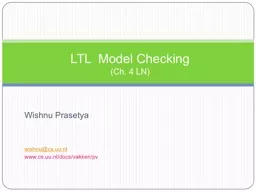PPT-Wishnu Prasetya wishnu@cs.uu.nl
Author : volatilenestle | Published Date : 2020-06-17
wwwcsuunl docs vakken pv LTL Model Checking Ch 4 LN Overview This pack Abstract model of programs Temporal properties Verification via model checking algorithm
Presentation Embed Code
Download Presentation
Download Presentation The PPT/PDF document "Wishnu Prasetya wishnu@cs.uu.nl" is the property of its rightful owner. Permission is granted to download and print the materials on this website for personal, non-commercial use only, and to display it on your personal computer provided you do not modify the materials and that you retain all copyright notices contained in the materials. By downloading content from our website, you accept the terms of this agreement.
Wishnu Prasetya wishnu@cs.uu.nl: Transcript
Download Rules Of Document
"Wishnu Prasetya wishnu@cs.uu.nl"The content belongs to its owner. You may download and print it for personal use, without modification, and keep all copyright notices. By downloading, you agree to these terms.
Related Documents


